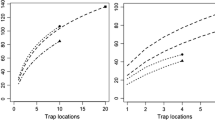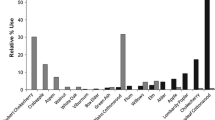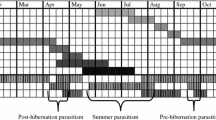Abstract
Functional traits quantify the distinctiveness of ecological communities and provide a theoretical basis for understanding inter-specific competition, competitive exclusion, and limiting similarity. Functional traits can also be used to evaluate the risk of exotic species and biological control agents. The generalist parasitoid Meteorus pulchricornis (Wesmael 1835) (Braconidae: Hymenoptera) was used as a case study to evaluate the potential for inter-specific competition with resident hymenopteran larval parasitoid species in New Zealand. Information on taxonomic and life history traits were collated from published and unpublished literature, while morphological traits were obtained by measuring specimens in the New Zealand Arthropod Collection. Functional trait information was gathered for 89 parasitoid species, and a hierarchical agglomeration approach was used to cluster species based on similarity. A principal component analysis identified several key traits, including host development (idiobiosis, koinobiosis), site of development (ectoparasitoid, endoparasitoid), progeny per host, the host stage attacked, and ovipositor morphology. Analysis show that M. pulchricornis has the potential to compete with a different range of species, including biocontrol agents, and endemic or native species. Functional trait information using the literature and taxonomic collections can be used to complement current risk assessment tools.



Similar content being viewed by others
References
Barratt B, Moeed A (2005) Environmental safety of biological control: policy and practice in New Zealand. Biol Control 35:247–252
Bartomeus I, Stavert J, Ward DF, Aguado O (2019) Historic collections as a tool for assessing the global pollinator crisis. Philos Trans R Soc B 374(1763):20170389
Berndt LA (2010) Will competition from Meteorus pulchricornis (Wesmael) (Hymenoptera: Braconidae) limit the success of the potential biocontrol agent Cotesia urabae Austin & Allen (Hymenoptera: Braconidae)? Aust J Entomol 49:369–376
Berry JA (1997) Meteorus pulchricornis (Wesmael) (Hymenoptera: Braconidae: Euphorinae), a new record for New Zealand. NZ Entomol 20:45–48
Berry JA, Walker GP (2004) Meteorus pulchricornis (Wesmael) (Hymenoptera: Braconidae: Euphorinae): an exotic polyphagous parasitoid in New Zealand. NZ J Zool 31:33–44
Bin F, Roversi PR, van Lenteren JC (2012) Erroneous host identification frustrates systematics and delays implementation of biological control. Redia 95:83–88
Brockerhoff EG, Barratt BI, Beggs JR, Fagan LL, Malcolm K, Phillips CB, Vink CJ (2010) Impacts of exotic invertebrates on New Zealand's indigenous species and ecosystems. NZ J Ecol 34:158–174
Cardinale BJ, Harvey CT, Gross K, Ives AR (2003) Biodiversity and biocontrol: emergent impacts of a multi-enemy assemblage on pest suppression and crop yield in an agroecosystem. Ecol Lett 6:857–865
Charles JG (2012) Assessing the non-target impacts of classical biological control agents: is host-testing always necessary? BioControl 57:619–626
Clarke KR and Gorley RN (2006) Primer v6 user manual/tutorial primer-e ltd Plymouth, England
Colautti R, Parker JD, Cadotte MW, Pyšek P, Brown CS, Sax D, Richardson D (2014) Quantifying the invasiveness of species. NeoBiota 21:7–27
Copping LG (2005) Natural enemies: an introduction to biological control. Cambridge University Press, Cambridge
Cornelissen JH, Makoto K (2014) Winter climate change, plant traits and nutrient and carbon cycling in cold biomes. Ecol Res 29:517–527
Diaz S, Cabido M, Casanoves F (1998) Plant functional traits and environmental filters at a regional scale. J Veg Sci 9:113–122
Edney-Browne E, Brockerhoff EG, Ward DF (2018) Establishment patterns of exotic insects in New Zealand. Biol Invas 20:1657–1669
Hardin G (1960) The competitive exclusion principle. Science 131:1292–1297
Hartnett D, MacDonald F, Martin N, Walker G, Ward DF (2018) Interactions between the exotic parasitoid Meteorus pulchricornis (Hymenoptera: Braconidae) and other larval parasitoids of native Lepidoptera. NZ J Zool 31:326–340
Harvey JA (2008) Comparing and contrasting development and reproductive strategies in the pupal hyperparasitoids Lysibia nana and Gelis agilis (Hymenoptera: Ichneumonidae). Evol Ecol 22:153–166
Harvey JA, Wagenaar R, Bezemer TM (2009) Life-history traits in closely related secondary parasitoids sharing the same primary parasitoid host: evolutionary opportunities and constraints. Entomol Exp et Appl 132:155–164
Horrocks KJ, Ward DF, Suckling DM (2019) Can natural enemies of current insect pests provide biotic resistance to future pests. Agric For Entomol 22(1):20–29
Johnson T (2013) Practical problems and their solutions in studying the biology of the mealybug Paracoccus burnerae (Brain) (Hemiptera: Pseudococcidae). Afr J Biotechnol 12:3609–3614
Kendall LK, Ward DF (2016) Habitat determinants of the taxonomic and functional diversity of parasitoid wasps. Biodivers Conserv 25:1955–1972
Kolar CS, Lodge DM (2002) Ecological predictions and risk assessment for alien fishes in North America. Science 298:1233–1236
Kumschick S, Bacher S, Dawson W, Heikkilä J, Sendek A, Pluess T, Robinson TB, Kühn I (2012) A conceptual framework for prioritization of invasive alien species for management according to their impact. NeoBiota 15:69–100
Le Lann C, Visser B, van Baaren J, van Alphen JJM, Ellers J (2012) Comparing resource exploitation and allocation of two closely related aphid parasitoids sharing the same host. Evol Ecol 26:79–94
Laliberté E, Legendre P (2010) A distance-based framework for measuring functional diversity from multiple traits. Ecology 91:299–305
Leibold MA, McPeek MA (2006) Coexistence of the niche and neutral perspectives in community ecology. Ecology 87:1399–1410
Lockwood JL, Hoopes MF, Marchetti MP (2013) Invasion ecology, 2nd edn. Wiley-Blackwell Somerset, Somerset
Louda SM, Pemberton R, Johnson M, Follett P (2003) Nontarget effects—The Achilles’ heel of biological control? Retrospective analyses to reduce risk associated with biocontrol introductions. Annu Rev Entomol 48:365–396
Mack RN, Simberloff D, Lonsdale MW, Evans H, Clout M, Bazzaz FA (2000) Biotic invasions: causes, epidemiology, global consequences, and control. Ecol Appl 10:689–710
Maechler M, Rousseeuw P, Struyf A, Hubert M, Hornik K, Studer M, Roudier P, Gonzalez J, Kozlowski, Schubert E, Murphy K (2016) ‘‘Finding groups in data”: cluster analysis extended. Available from https://cran.r-project.org/web/packages/cluster/cluster.pdf. Accessed on 16 Mar 2016
Messing RH, Wright MG (2006) Biological control of invasive species: solution or pollution? Front Ecol Environ 4:132–140
Moran VC, Hoffmann JH, Zimmermann HG (2005) Biological control of invasive alien plants in South Africa: necessity, circumspection, and success. Front Ecol Environ 3:71–77
Morin PJ (2011) Community ecology. Wiley, Hoboken
Munro V, Henderson I (2002) Nontarget effect of entomophagous biocontrol: shared parasitism between native lepidopteran parasitoids and the biocontrol agent Trigonospila brevifacies (Diptera: Tachinidae) in forest habitats. Environ Entomol 31:388–396
Navas M, Violle C (2009) Plant traits related to competition: how do they shape the functional diversity of communities? Community Ecol 10:131–137
New Zealand Organisms Register (2016) New Zealand organisms register. Available from https://www.nzor.org.nz/. Cited on 10 Feb 2016
Noyes JS (1994) The reliability of published host-parasitoid records: a taxonomist’s view. Norwegian J Agric Sci 16:59–69
Parr CL, Dunn RR, Sanders NJ, Weiser MD, Photakis M, Bishop TR, Brandão CR (2017) GlobalAnts: a new database on the geography of ant traits (Hymenoptera: Formicidae). Insect Conserv and Diver 10:5–20
Peterson AT, Vieglais DA (2001) Predicting species invasions using ecological niche modeling: new approaches from bioinformatics attack a pressing problem: a new approach to ecological niche modeling, based on new tools drawn from biodiversity informatics is applied to the challenge of predicting potential species' invasions. BioScience 51:363–371
Prins HH, van Langevelde F (2008) Resource ecology: spatial and temporal dynamics of foraging. Springer, Berlin
Probert AF, Ward DF, Beggs JR, Lin S-L, Stanley MC (2019) Conceptual risk framework: integrating ecological risk of introduced species with recipient communities. BioScience 70:71–79
Quicke D (2015) The braconid and ichneumonid parasitoid wasps: biology, systematics: evolution and ecology. Wiley, New York
R Core Team (2013).R: a language and environment for statistical computing. Retrieved from https://www.r-project.org/.
Rand TA, Tylianakis JM, Tscharntke T (2006) Spillover edge effects: the dispersal of agriculturally subsidized insect natural enemies into adjacent natural habitats. Ecol Lett 9:603–614
Ripley B, Venables, B, Bates DM, Hornik K, Gebhardt A, Firth D, Ripley MB (2015) Package ‘mass’. Available from https://cran.r-project.org/web/packages/MASS/MASS.pdf. Cited on 21 Jun 2016
Rocha LA, Aleixo A, Allen G, Almeda F, Baldwin CC, Barclay M, Witt CC (2014) Specimen collection: an essential tool. Science 344:814–815
Roland J, Taylor PD (1997) Insect parasitoid species respond to forest structure at different spatial scales. Nature 386:710–713
Schaffner U (2001) Host range testing of insects for biological weed control: how can it be better interpreted? data on the host range of biocontrol candidates are particularly relevant in assessing potential detrimental effects to nontarget organisms. BioScience 51:951–959
Schnitzler F, Hartley S, Lester PJ (2011) Trophic-level responses differ at plant, plot, and fragment levels in urban native forest fragments: a hierarchical analysis. Ecol Entomol 36:241–250
Seebens H, Blackburn TM, Dyer EE, Genovesi P, Hulme PE, Jeschke JM, Pagad S, Pyšek P, van Kleunen M, Winter M, Arianoutsou M, Bacher S, Blasius B, Brockerhoff EG, Brundu G, Capinha C, Causton CE, Celesti-Grapow L, Dawson W, Dullinger S, Economo EP, Fuentes N, Guénard B, Jäger H, Kartesz J, Kenis M, Kühn I, Lenzner B, Liebhold A, Mosena A, Moser D, Nentwig W, Nishino M, Pearman D, Pergl J, Rabitsch W, Rojas-Sandoval J, Roques A, Rorke S, Rossinelli S, Roy HE, Scalera R, Schindler S, Štajerová K, Tokarska-Guzik B, Walker K, Ward DF, Yamanaka T, Essl F (2018) The global rise in emerging alien species results from increased accessibility of new source pools. Proc Natl Acad Sci USA 115(10):E2264–E2273
Shea K, Chesson P (2002) Community ecology theory as a framework for biological invasions. Trends Ecol Evol 17:170–176
Sivinski J, Vulinec K, Aluja M (2001) Ovipositor length in a guild of parasitoids (Hymenoptera: Braconidae) attacking Anastrepha spp. fruit flies (Diptera: Tephritidae) in southern Mexico. Ann Entomol Soc Am 94:886–895
Tilman D (1982) Resource competition and community structure. Princeton University Press, Princeton
Todd JH, Barratt BI, Tooman L, Beggs JR, Malone LA (2015) Selecting non-target species for risk assessment of entomophagous biological control agents: evaluation of the PRONTI decision-support tool. Biol Control 80:77–88
Tracy EF (2014) The promise of biological control for sustainable agriculture: a stakeholder-based analysis. J Sci Policy Gov 5:1–13
van Lenteren J, Babendreier D, Bigler F, Burgio G, Hokkanen H, Kuske S, Loomans AJM, Menzler-Hokkanen I, van Jijn PCJ, Thomas MD (2003) Environmental risk assessment of exotic natural enemies used in inundative biological control. BioControl 48:3–38
van Lenteren J, Bale J, Bigler F, Hokkanen H, Loomans A (2006) Assessing risks of releasing exotic biological control agents of arthropod pests. Annu Rev Entomol 51:609–634
Walker GP, Cameron, PJ (1989) Status of introduced larval parasitoids of tomato fruitworm. In: Proceedings of the 42nd NZ weed & pest control conference 8–10 Aug 1989 Dunedin New Zealand, pp 229−232
Walker G, Herman T, Qureshi M, Winkler S, Wallace A (2005) Parasitism of tomato fruitworm larvae in process tomatoes at Pukekohe. N Z Plant Prot 58:224–228
Walker GP, MacDonald FH, Wallace AR, Cameron PJ (2016) Interspecific competition among Cotesia kazak, Microplitis croceipes, and Meteorus pulchricornis (Hymenoptera: Braconidae), larval parasitoids of Helicoverpa armigera (Lepidoptera: Noctuidae) in New Zealand. Biol Control 93:65–71
Ward DF (2012) More than just records: analysing natural history collections for biodiversity planning. PLoS ONE 7(11):e50346
Ward DF, Edney-Browne E (2015) Poles apart: comparing trends of alien Hymenoptera in New Zealand with Europe (DAISIE). PLoS ONE 10(7):e0132264
Ward DF, Leschen RA, Buckley TR (2015) More from ecologists to support natural history museums. Trends Ecol Evol 30:373–374
Ward DF, Stanley MC, Toft RJ, Forgie SA, Harris RJ (2008) Assessing the risk of invasive ants: a simple and flexible scorecard approach. Insectes Soc 55:360–363
Acknowledgements
This work was supported by funding from MBIE to Landcare Research within the Biota Portfolio, and the B3 (Better Border Biosecurity) Collaboration.
Author information
Authors and Affiliations
Corresponding author
Ethics declarations
Conflict of interest
The authors declare that they have no conflict of interest.
Additional information
Handling editor: David Andow
Electronic supplementary material
Below is the link to the electronic supplementary material.
Rights and permissions
About this article
Cite this article
McGrath, Z., MacDonald, F., Walker, G. et al. A framework for predicting competition between native and exotic hymenopteran parasitoids of lepidopteran larvae using taxonomic collections and species level traits. BioControl 66, 59–69 (2021). https://doi.org/10.1007/s10526-020-10025-y
Received:
Accepted:
Published:
Issue Date:
DOI: https://doi.org/10.1007/s10526-020-10025-y




